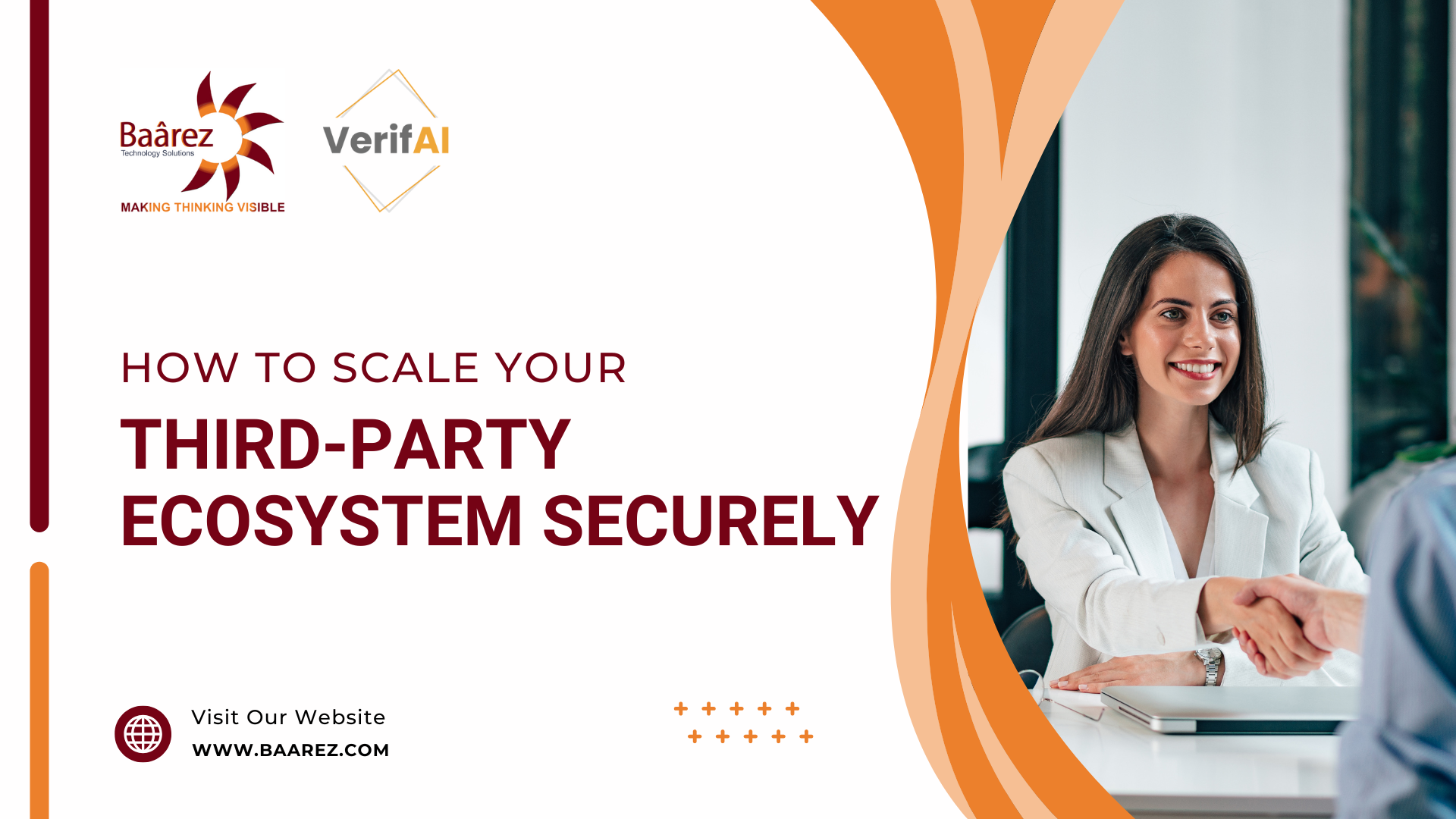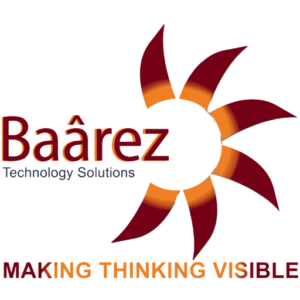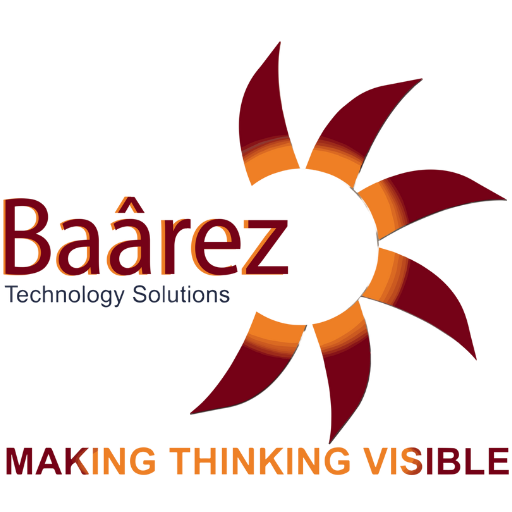
In today’s interconnected world, businesses are growing fast by building extensive third-party ecosystems. These ecosystems include suppliers, vendors, contractors, partners, and service providers that help organizations operate efficiently. However, as the ecosystem grows, so do the risks. The key question is: how can you scale your third-party ecosystem securely?
In this guide, we’ll explore:
- What a modern third-party ecosystem looks like
- The most common third-party risks
- How to manage and measure your third-party ecosystem
- How Baarez’s AI-powered solution can help you scale securely
Let’s get started by understanding the nature of today’s third-party networks.
Table of Contents
ToggleWhat does a modern third-party ecosystem look like?
A modern third-party ecosystem is a complex and dynamic network of external entities that contribute to your business operations. It goes beyond traditional vendors and includes:
- Cloud service providers
- Software-as-a-Service (SaaS) vendors
- Freelancers and consultants
- IT support and infrastructure partners
- Logistics and supply chain providers
- Outsourced customer service
This network can span across different countries, industries, and regulatory environments.
Key Characteristics of Modern Third-Party Ecosystems:
Feature | Description |
Global Distribution | Partners may operate from multiple countries, increasing exposure to risk. |
Digital Interconnection | Data is shared across systems and platforms in real-time. |
Outsourced Functions | Businesses outsource more critical functions than ever before. |
Rapid Onboarding | New vendors are added quickly to support scaling efforts. |
Regulatory Diversity | Vendors fall under different laws, making compliance more challenging. |
Why It Matters
As organizations rely more on third parties to stay competitive, they must scale with security in mind. A single weak link in your ecosystem can lead to data breaches, compliance violations, or operational disruptions.
Scaling your third-party ecosystem securely starts with understanding the risks involved — and that’s what we’ll dive into next.
What are the most common third-party risks?
When expanding your ecosystem, understanding the types of third-party risks is essential. These risks can impact your security, operations, finances, reputation, and compliance. Failing to assess and mitigate them could result in data breaches, service disruptions, or legal penalties.
Let’s break down the most common third-party risks businesses face:
1. Cybersecurity / InfoSec Risk
This involves threats to your data, systems, and infrastructure through third-party access.
- Unauthorized access to sensitive data
- Malware or ransomware introduced via vendor systems
- Poor cybersecurity hygiene by vendors
Mitigation Tip: Ensure vendors follow industry-standard security protocols and are regularly assessed for vulnerabilities.
2. Data Privacy
Vendors often handle or store personal data, creating privacy concerns.
- Mishandling of customer or employee information
- Violations of regulations like GDPR or CCPA
- Lack of encryption or access controls
Mitigation Tip: Include data privacy clauses in contracts and conduct privacy impact assessments.
3. Operational Risk
Operational risk arises when a third party fails to deliver goods or services as expected.
- Service outages or downtime
- Failure to meet quality standards
- Inadequate capacity during peak demand
Mitigation Tip: Define clear performance expectations and monitor vendor KPIs regularly.
4. Financial Risk
This includes risks related to a third party’s financial instability or fraud.
- Vendor insolvency
- Late or missed payments
- Fraudulent billing practices
Mitigation Tip: Evaluate financial health during onboarding and monitor it periodically.
5. Compliance and Legal Risk
When vendors fail to comply with regulations, your organization could be held accountable.
- Breach of industry or regional compliance (HIPAA, PCI-DSS, etc.)
- Improper licensing or legal violations
- Breach of contract terms
Mitigation Tip: Include compliance audits and legal obligations in third-party agreements.
6. Strategic and Performance Risk
This risk occurs when a third party’s goals or capabilities no longer align with your business.
- Misalignment of objectives
- Inability to scale alongside your growth
- Poor service delivery impacting business goals
Mitigation Tip: Evaluate vendor strategy alignment during selection and regularly review performance metrics.
7. Reputational Risk
A vendor’s poor conduct can damage your brand’s image.
- Association with unethical practices
- Negative media coverage
- Customer backlash due to vendor actions
Mitigation Tip: Monitor vendor reputation using media and third-party risk platforms.
8. Geopolitical Risk
This includes risks arising from political instability, regulations, or sanctions in the vendor’s region.
- Trade restrictions or tariffs
- Political unrest disrupting operations
- Sanctions against foreign suppliers
Mitigation Tip: Diversify vendors across geographies and monitor geopolitical developments.
9. Concentration and Supply Chain Risk
Relying too heavily on one or a few vendors can create serious dependencies.
- Single point of failure
- Supply chain bottlenecks
- Lack of alternative sourcing
Mitigation Tip: Map your supply chain and ensure diversification of critical vendors.
How to Manage and Measure Your Third-Party Ecosystem
Once you understand the risks involved, the next step in learning how to scale your third-party ecosystem securely is developing a robust management strategy. Managing and measuring third-party relationships isn’t a one-time effort—it requires ongoing attention, clear processes, and the right tools.
Here are seven key practices that will help you keep your third-party network secure, efficient, and aligned with your business goals:
1. Conduct Comprehensive Due Diligence
Before onboarding any vendor or partner, perform a thorough evaluation.
Key Areas to Assess:
- Financial stability
- Security certifications (e.g., ISO 27001, SOC 2)
- Regulatory compliance
- Operational capacity
- Reputation and legal history
Checklist:
Due Diligence Item | Description |
Financial Review | Analyze reports, debts, and liquidity |
Security Controls | Check for firewalls, encryption, access controls |
Compliance Verification | Confirm industry regulation adherence |
Background Check | Review past legal or reputational issues |
2. Perform a Data and Risk-Informed Assessment
After onboarding, continuously evaluate third parties based on data, performance, and risk level.
Tips:
- Classify vendors based on criticality and data access
- Assess risk impact and likelihood
- Update assessments periodically
Use a risk heat map to visualize and prioritize vendors needing closer oversight.
3. Implement Strong Contracts and SLAs
Clearly defined agreements form the foundation for secure third-party relationships.
Essential Elements to Include:
- Service Level Agreements (SLAs)
- Data protection clauses
- Termination and exit strategies
- Regulatory compliance terms
- Penalties for non-compliance
A well-written contract reduces ambiguity and sets enforceable expectations.
4. Monitor and Audit Regularly
Ongoing oversight ensures that vendors continue to meet your standards.
What to Monitor:
- SLA performance metrics
- Security logs and access reports
- Compliance with industry standards
Schedule regular audits—both internal and third-party conducted—to catch issues early.
5. Utilize Technology for Risk Management
Leverage AI-driven risk management tools to automate and streamline third-party monitoring.
Benefits of Using Technology:
- Real-time threat detection
- Automated risk scoring
- Centralized vendor data
- Integration with GRC platforms
This enables you to scale your third-party ecosystem securely without increasing manual workload.
6. Develop a Strong Incident Response Plan
Not every risk can be prevented—but you can control how you respond.
Your Incident Plan Should Cover:
- Clear roles and responsibilities
- Communication protocols
- Regulatory notification timelines
- Remediation procedures
Test your incident response plan regularly with simulated scenarios.
7. Foster Transparent Communication
Strong relationships depend on open and frequent communication with your third-party partners.
Ways to Improve Communication:
- Schedule quarterly business reviews (QBRs)
- Share performance dashboards
- Discuss potential risks and improvements proactively
Open dialogue builds trust and aligns both parties on security and performance goals.
Strengthen the Ecosystem with Baarez AI-Powered Third-Party Management
Effectively scaling your ecosystem requires more than manual checklists and spreadsheets. To stay ahead of evolving threats and complex compliance demands, organizations need intelligent, automated solutions.
Baarez AI-Powered Third-Party Management is designed to help businesses scale their third-party ecosystems securely—without compromising visibility, control, or performance.
Key Benefits of Baarez AI-Powered Third-Party Management
Here’s how Baarez makes third-party management easier, smarter, and more secure:
Feature | Benefit |
Automated Risk Detection | Identifies high-risk vendors in real-time using AI-driven risk scoring. |
Centralized Vendor Intelligence | Consolidates data, performance metrics, and risk levels in one platform. |
Customizable Dashboards | Offers role-based dashboards for legal, security, and procurement teams. |
Regulatory Compliance Monitoring | Tracks compliance with global standards like GDPR, HIPAA, and ISO. |
Smart Alerts & Notifications | Provides proactive alerts on risk changes or SLA violations. |
Integrated Due Diligence Tools | Automates background checks, document collection, and risk assessments. |
Incident Management & Response | Enables fast, coordinated response to vendor-related incidents. |
Why Choose Baarez?
Baarez enables you to:
- Scale faster without sacrificing control
- Reduce risk through predictive analytics
- Improve collaboration across internal teams and external partners
- Stay audit-ready with continuous documentation and compliance tracking
Whether you manage ten vendors or ten thousand, Baarez gives you the tools to confidently grow your network while maintaining security, resilience, and compliance.
Final Thoughts
Learning how to scale your third-party ecosystem securely is essential in a digital-first, global business environment. From identifying risks to monitoring performance, every step matters—and the right technology partner can make a world of difference.
Ready to secure and optimize your third-party relationships?
Talk to Baarez Technology Solutions today and transform how you manage your third-party ecosystem.


